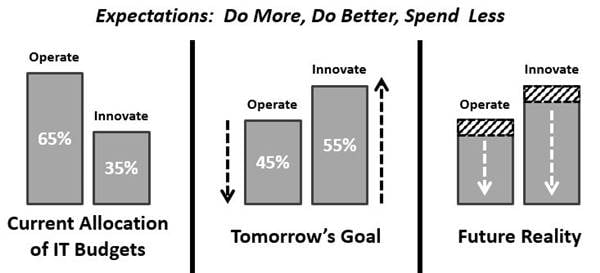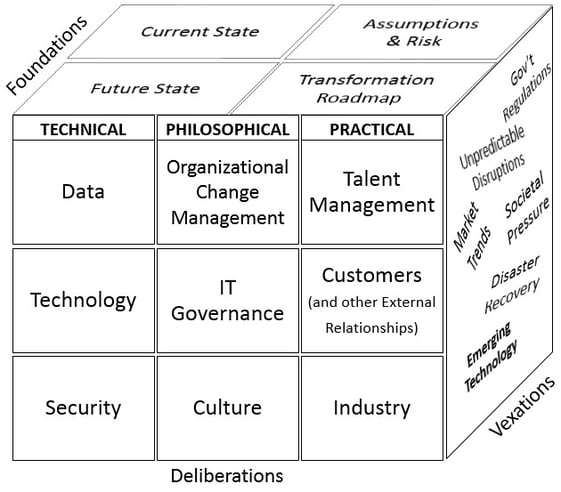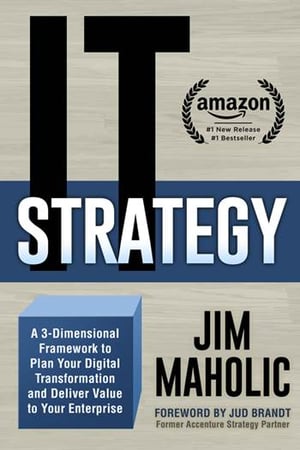The key to a winning IT strategy is elevating innovation over operations in order to deliver a competitive advantage. Whether your objective is to gain first-mover advantage, achieve better market penetration, or drive out non-value-added costs, a winning IT strategy supports the established corporate strategy to make this happen.
When creating an IT strategy, the driving consideration is about strategy and not technology. Your executive committee may – and should – measure your IT strategy against The SEAR Imperative, which states that every proposal that seeks funding – IT strategy or otherwise – must demonstrate that it favorably influences Sales, Expenses, Assets and Risks if you wish to receive approval.
As you begin planning your IT strategy, you’ll find it helpful to anticipate four core executive questions, and prepare a sound answer for each. The four questions are:
- What business problem(s) are we trying to solve that we currently cannot?
- Why can’t we just tweak existing solutions to address the stated business challenges?
- Why is this transformation (and its associated investment) needed now?
- If approved for funding, how effectively does the strategy address The SEAR Imperative?
To help focus your thinking, I present five common objectives of a successful IT strategy. I use the acronym D.R.E.S.S:
- Disrupt
- Rationalize
- Economize
- Standardize
- Simplify
Disrupt
In today’s business climate, you are either the disrupter or the disrupted. To be an effective disrupter you must play both offense and defense. On offense, many enterprises are focusing on transforming their customer experience. This makes sense as this is where your customers interact with you.
But don’t overlook defense. Evaluate ways that your enterprise is vulnerable to disruption by various external disrupters. Once you get a handle on your ability to cause disruption and adapt when victimized by it, turn your attention to efficiency.
Rationalize
Your overall environment must be rationalized. In nearly every enterprise, there is a complex array of data challenges. Consider assigning a team to review and rationalize your existing data, especially your primary data stores such as customer, employee, vendor and parts masters. You will want to address any data integrity concerns before moving into your future state.
Many companies have multiple solutions that do the same thing. (Analysis and reporting tools quickly come to mind). Such redundancy adds cost and complexity. Part of your rationalization exercise will include reviewing your current project portfolio. Which current projects might be superseded by your future state and, of those, which could be discontinued?
Finally, don’t overlook your current contracts. As new solutions are acquired from the same vendor, the opportunity to rationalize your vendor contracts, including discussing coterminous contract end-dates is always worth reviewing.
Economize
The goal for tomorrow’s IT environments is to reallocate budgets from spending on routine operation to investing in game-changing innovation. Once that is achieved, CIOs can expect additional pressure to drive out additional costs without sacrificing service or security.

Standardize
Standardization is akin to rationalization, with the added component of compliance monitoring. Standardization reduces variability and complexity by imposing rigidity. Striving for standardization requires enforcing standards and holding the non-compliant accountable. This requires a sound organizational change management focus.
As you reduce complexity, you coincidentally reduce cost and enable agility. It is not practical to achieve 100% standardization, but more standardization is better than more variability. Standardization, along with rationalization, make for a more efficient IT future state.
Simplify
In the lean manufacturing world, much effort is invested to design things using the fewest unique components. Fasteners, such as screws, are used to manufacture many durable goods. The manufacturer gains manufacturing efficiency and a purchase price advantage when it buys 10,000 of a single type of screw rather than buying 1,000 of ten different screws that are different thread sizes and lengths. The same planning logic applies to IT solutions, such as data analytics. Rather than dozens of such tools, reducing the portfolio saves the company money and will be simpler to support.
The 3-D IT Strategy Cube
To help visualize and develop an IT strategy, I developed the 3-D IT Strategy Cube.

The 3-D IT Strategy Cube
Copyright © 2019 Jim Maholic. All rights reserved.
Unpacking the 3-D IT Strategy Cube is the primary objective of my latest book, IT Strategy. Across the top is the Foundations dimension. It provides the framework for all strategic planning. The front-facing Deliberations dimension is the core of IT Strategy. Of key interest is the alignment of each topic to The SEAR Imperative. For example, how does the future state of your data strategy or your security umbrella favorably influence sales, expenses, assets or mitigate some risk?
 Call to Action
Call to Action
As you plan your IT Strategy keep the above D.R.E.S.S. principles in mind. Finally, the following three considerations should be addressed and woven into your document as you create your strategic proposal:
- Review the four core executive questions at the start of this article.
- What is your plan to get the Deliberation elements from the current state to the future state? This includes a roadmap, staffing considerations, timing of funding needs and the decommissioning of superseded solutions.
- What assumptions are you making regarding your ability to successfully execute this strategy? Such assumptions around talent, security, governance, customer experience and your organization’s ability to effectively drive change should be documented.
By addressing these considerations within your final proposal, you can be confident that your IT strategy will receive a fair hearing.
Go forth and conquer!


Written by Jim Maholic
Jim Maholic has over 25 years of experience as an IT strategist. His career has included two stints as a CIO, executive positions with Big Four and regional consulting firms, and leadership roles with enterprise software companies. He is an award-winning, bestselling author, having written IT Strategy and Business Cases that Mean Business.



